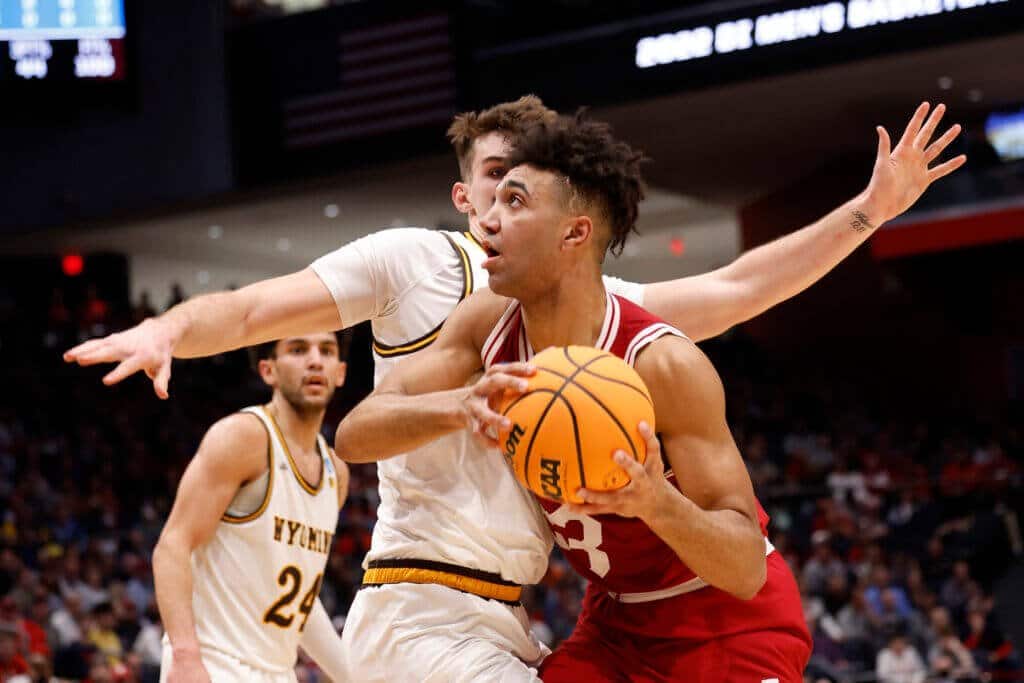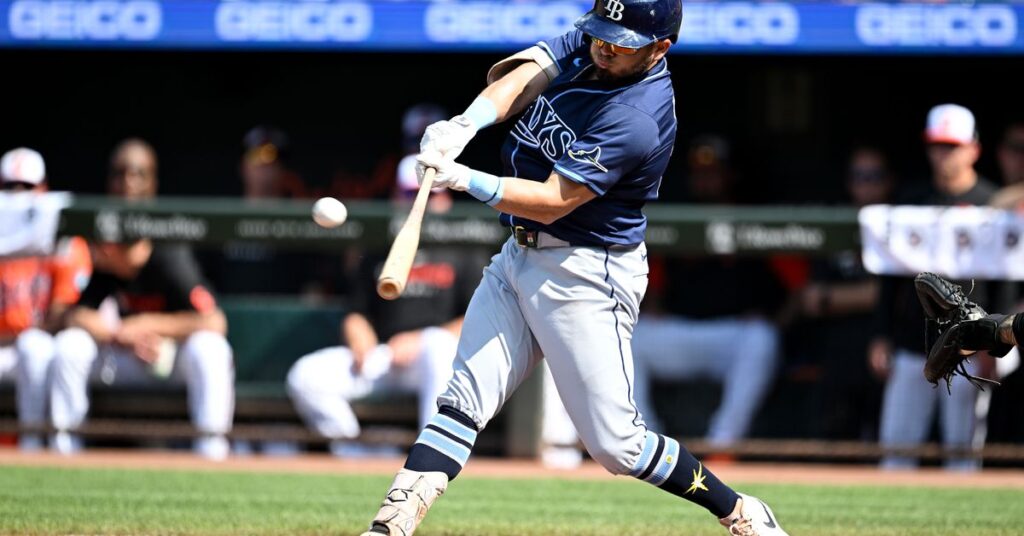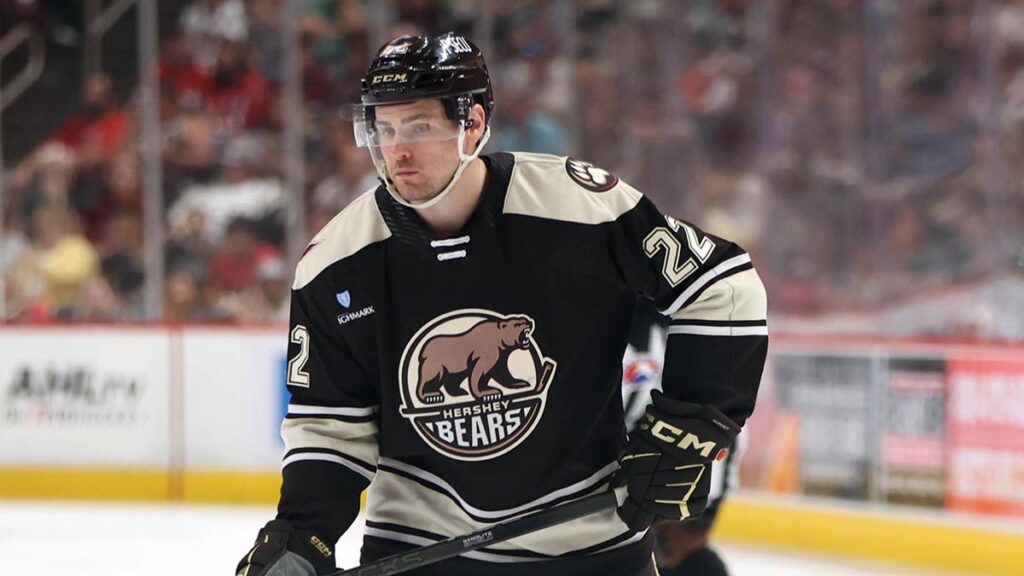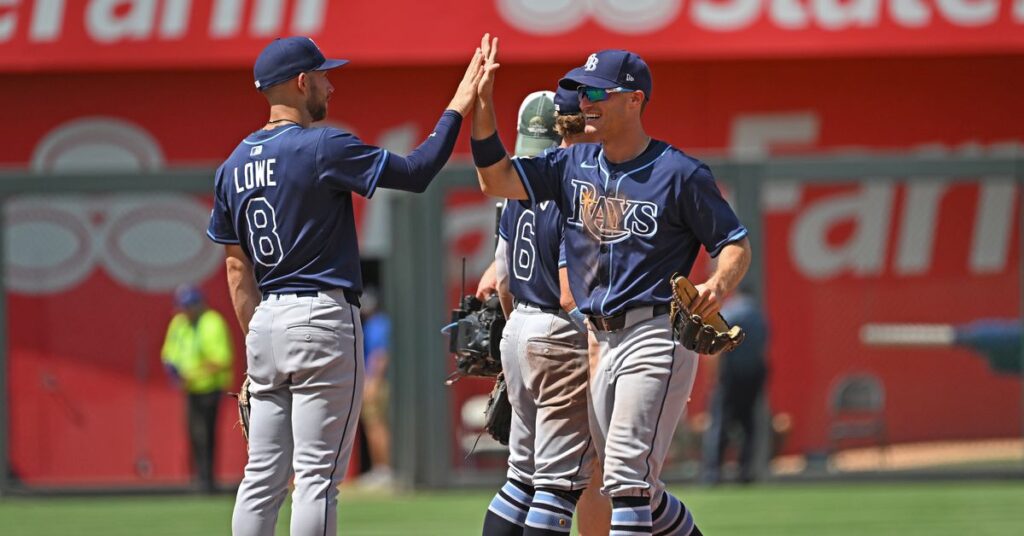In May, when star Indiana forward Trayce Jackson-Davis announced — with relatively minimal fanfare for an announcement and a Zoom call — his return for a senior season, it was easy to treat the move as perfunctory, of a kind. By then star North Carolina national runner-up Armando Bacot, Kentucky’s national player of the year Oscar Tshiebwe and Michigan center Hunter Dickinson had all made clear their intentions to return to the college game. Gonzaga’s Drew Timme was still weighing his NBA options, which was a statement in itself; he, too, would ultimately remain in school.
Two fascinating trends were working in tandem: The NBA was more or less abandoning classic back-to-the-basket big men (at least those without elite, switchable defensive talent) all the while these hugely impactful stars were able to make a personal profit from their talent in college. All of a sudden, it didn’t just make a kind of vague, hopeful basketball sense to stay on campus for another season, but clear financial sense too.
So it was easy — at least for a college basketball writer working on a feature about those trends at the time — to kind of brush past the actual basketball impact of Jackson-Davis’s return. Ho-hum, right?
It’s a massive deal. It was a coup when Woodson was able to convince Jackson-Davis to stay for the player’s junior year, Woodson’s first as IU coach; having the big man back yet again goes beyond any Indiana fan’s expectations circa, say, early 2021. No one would have foreseen arriving at the 2022-23 season with one of the best five or six players in college basketball, a totem around which all else can be built.
And that is really the question for this Indiana team: Can Woodson build out the rest? Plenty of returners are here, but from a bubble team that waxed and waned, that struggled at times to play efficient offense around their hyper-efficient star in the middle, that took until late in the year to remotely click. The Hoosiers were a very good defensive team, the stingiest per possession in the Big Ten, with decent offensive spacing and plenty of transition opportunities, but one whose turnovers and inability to make perimeter shots once again made it very easy to guard. Indiana was the 10th-most efficient offense in its own league. No team with Trayce Jackson-Davis should ever be so resoundingly mid at scoring the ball.
Once more, Indiana will revolve around one of the best players in the country. Can the rest of this experienced rotation, with the help of some very talented true freshmen, rise to meet him at that level? Here is a look at every IU scholarship player as they barrel toward what they hope will be a breakthrough season for the program:
Trayce Jackson-Davis, senior, forward
Because here’s the thing about Jackson-Davis: He could make zero functional improvement in 2022-23 and still be comfortably one of the best 10 players in men’s college basketball — and maybe one of the best four or five.
Jackson-Davis can be a joy to watch. He moves well, picks out great angles, and contorts his body to find left-handed finishes that seem impossible a half-second before he creates them. His combination of size and leaping and release angle make him pretty much unstoppable around the rim. For someone whose best work is so predicated on size and power, he is unusually creative with the ball in his hands. In any case, he is extremely effective. When he dives to the front of the rim — especially, in Woodson’s offensive system, as a screen setter — and catches the ball in the middle of the floor, he gets easy buckets in abundance. He faces up well on the baseline. Most of his classic post-up touches end well. He dunks on people’s heads.
He has also, by this point, turned into a very solid defender, a good shot-blocker and changer who looks solid switching onto, and then containing, guards on the perimeter.
So why isn’t Jackson-Davis a pro? In part, this season anyway, because he got COVID-19 when he was supposed to be at the draft combine, timing which scuppered his chances of going and proving his practicable NBA skills. Jackson-Davis is convinced he can do the things NBA scouts want to see from him, namely, shooting reliably from the perimeter, things Indiana didn’t really want him to do in lieu of another easy dunk over some overwhelmed defender.
He could yet be an NBA player — one scout told me this summer that he can see a case for Jackson-Davis as a potential bench guy, given how well he moves and how physically he plays — but 10 years ago Jackson-Davis would have been a lottery pick, and it probably wouldn’t have taken him this long to realize that outcome.
Instead, he has a chance to cement a legacy at Indiana. He is already one of the best individual players of the post-Bob Knight era. He might be the best Indiana big since Alan Henderson. (Cody Zeller might like a word, but it’s at least a debate.) But for as good as he has been, and for as dominant as his junior season was, he has yet to experience the kind of collective success that really makes IU fans remember you fondly. There are improvements Jackson-Davis can make individually, marginal gains in every area, in addition to the big leap he could theoretically make as a perimeter finisher. But Indiana doesn’t need him to shoot a bunch of jump shots, and it’s not clear that forcing up a bunch of 3s is going to affect his draft stock anyway.
“Everyone likes to talk about him shooting the jumper, and he can extend his range, he has extended it, but the things NBA teams want to see him do well is: make free throws, set screens, get off screens, rim run, catch lobs, rebound and defend in the pick and roll,” associate head coach Yasir Rosemond said. “There is not a team in the NBA that wants Trayce to shoot 3-point shots.”
By being good at so much so close to the rim, Jackson-Davis creates the age-old interior gravity that tugs defenses away from teammates out top. According to its own internal numbers, Indiana created a high rate of open 3s last season — and yet generated just 24.9 percent of its total points from beyond the arc. “We showed that stat to Coach and he lost his mind,” Rosemond said. Understandably so.
Jackson-Davis wants to have the kind of season that is about more than individual brilliance on a mediocre team. He has been remarkably candid about his goals for 2022-23. “The ceiling for our team is anywhere from Big Ten championship to national championship,” Jackson-Davis said when he announced his return. “I set my standards high.” Jackson-Davis will look to get better, because of course he will, but even if he doesn’t, he likely will set a host of serious school records.
Meanwhile, Indiana will have every chance to be a much, much better team than it was last season. “We have got enough guys that are putting in time this summer that I feel good about when they lace it up next year that they can make it,” Woodson said this summer. “That’s the way I feel. They have got to make shots.” With Jackson-Davis in the middle, it really could be just that simple.
Xavier Johnson is back to run Indiana from the point. (Rick Osentoski / USA Today)
Xavier Johnson, senior, guard
In the wake of his post-return press conference, in the process of being extremely candid about his goals for the team and where he thought Indiana could improve, Jackson-Davis made an interesting comment about his team’s point guard. “We’re going to make the right decisions,” he said. “He’s going to make the right decisions for us. There’s not going to be any of that, no funny business going on. X is going to have his head straight.” This was an apparent reference to Johnson’s April arrest for reckless driving — did we mention Jackson-Davis was really candid this summer? — but it could probably double as a statement on the way Johnson played for much of his first season in Bloomington.
When Johnson was good, especially as he found his balance down the stretch, he was really, really good. A livewire ballhandler in the open court, Johnson can blow by just about anyone in the college game. He posted the fourth-highest assist rate in the country at Pittsburgh as a junior; at Indiana, he ranked 14th. When he made 3s, he became extremely difficult to guard. He provided a spark for Indiana that it missed in prior seasons, athleticism and drive at the point of attack.
He also, shall we say, played on the edge. He talked trash. He clapped in opponents’ faces. He did questionable things after big buckets. He flirted with disaster. All of which would be fine were he Chris Paul, but Johnson struggled with reads out of the pick-and-roll for much of the season and turned the ball over all the time.
Some of that stuff is just your standard collegiate point guard learning curve, especially for a guy being asked to play the position in a read-heavy NBA style. “It’s a learning experience playing for Coach, who has been in the NBA game for 30 years, and you know the pressure those guys put on their point guards,” Rosemond said. “Some of those turnovers are just about making reads out of the pick-and-roll, thinking too much. Once he got in the flow of it and started understanding it, he was really good.”
But some of it was about keeping his head straight, too. There is a bit of a theme there. A focused, locked-in Johnson is a massive asset. But if he’s turning the ball over and crossing the line into “oh God, Xavier is about to get a technical here” territory, it is hard to rely on him in the way Indiana would like to.
Race Thompson, senior, forward
Race Thompson is probably underrated. It isn’t easy to get your flowers playing in the same frontcourt as Jackson-Davis, but Thompson quietly facilitates a lot of what makes Jackson-Davis so good. He is a great rebounder, particularly on the defensive end, which last season allowed Jackson-Davis to fly off across the lane hunting for blocks. Thompson’s strength gives him a chance to keep opposing star bigs off the block and help keep Jackson-Davis from having to constantly guard all of the Big Ten’s coterie of bigs.
Thompson also creates space on the offensive end, within reason. He shot 15-of-55 from 3 last season, though that number of shots dwarfed all that had come before, which maybe bodes well for Thompson’s floor-spacing potential this season. But his 2-point jump shooting was excellent. Thompson attempted 36.5 percent of his field goals from midrange and made 45.8 percent of those shots. It’s a high number for an out-of-style place on the floor. (Jackson-Davis made 35.7 percent, for comparison’s sake. Johnson made 27.8 percent, which, yeah: Stick to 3s and layups, Xavier.) Thompson isn’t some unicorn burying 3s out to the logo, but he is able to play away from the rim, which keeps his strengths on the floor without crowding Jackson-Davis with his extra defender under the rim.
Of course, more space is always better. “I’ve really been working on perimeter shooting,” Thompson said. “They’ve been working with me on it a lot, showing me what I need to do, what I need to change about my shot, just little tiny things to make my shot more consistent. We’ve seen improvements already.” Thompson is one of the leaders of the team; he’s going to play a lot, regardless of the freshman talent that just arrived in his position. If he can become a usable 3-point threat, Indiana’s offense will look very different. More fluidity and flexibility at that position may simply come from other player profiles, while Thompson continues to serve his complementary frontcourt role with aplomb.
Jalen Hood-Schifino, freshman, guard
This is where things start to get interesting. Returners are all well and good, and any team that brings back Jackson-Davis, Thompson and Johnson should be close to the top of the Big Ten standings projections. But there is also always the risk that running it back with the same team simply produces the same results. Indiana needs more — more talent, more flexibility, more dynamism. Jalen Hood-Schifino should provide it.
Hood-Schifino is the marquee incoming recruit of Woodson’s tenure to date. A five-star prospect and one of the brighter lights in another glowing Monteverde menagerie, Hood-Schifino is a versatile 6-foot-5 combo guard most at home attacking defenses with the ball in his hand. He drives both sides, finishes in a variety of ways, and has a handy, quick little pull-up jumper he can get to when the defense manages to stay in front. (This is a pretty good compilation of his highlights against top competition last season.) How all of this works at the college level remains to be seen, obviously, but even here his combination of size and skill will make him unusual. While not an overwhelming athlete, he can get to just about any spot on the floor that he wants, and then has the feel and intelligence to figure it out from there.
What he is not, at least traditionally, is a 3-point shooter. In theory, Hood-Schifino seems likely to take Parker Stewart’s minutes at the two. A backcourt of Johnson and Hood-Schifino seems extremely dynamic and fun to watch — but it also loses Stewart’s near 40 percent 3-point shooting. Stewart needed lots of screens and off-ball action to get looks, though; he couldn’t create his own shot. Hood-Schifino can, and his shooting mechanics look like they should reliably extend to the 3-point line eventually.
That is the early read from the Indiana staff, anyway. “He’s improved the jump shot,” Rosemond said. “But he makes passes that guys at the next level make. He’s a big body guard that finishes at the rim, and he’s going to have opportunities right away.” Maybe he’ll dominate from the start, but more likely, he will merely inject something new and exciting into Indiana’s offensive structure, while his versatility at the guard spots will give Woodson the chance to play around with more fluid lineups and matchups than the mostly conventional roles he stuck to last season. (More on that below.)
Miller Kopp, senior, wing
In some ways, it’s easy to get a read on Miller Kopp. He is a 6-7 3-and-D wing. Those are valuable guys to have around, and Kopp’s performance last season had definite value. At his size, he was a good defender able to guard multiple spots, while also stretching defenses with 36 percent 3-point shooting. If that’s all Kopp provides in his fifth season as a collegiate basketball player, that’s probably about enough.
Still, there were clear flaws, areas for improvement, that frustrated some IU fans last season. For example, Kopp shot just 34.9 percent from inside the arc. When defenses ran him off the arc, he settled for a lot of midrange jumpers; 39.2 percent of his total field goals were midrange shots, and he made just 31.6 percent of them. He attempted just 5.2 percent of his field goals at the rim. That’s right: 5.2 percent! Go to the rim, Miller! You are 6-foot-7, brother!
Indiana got plenty of interior buckets anyway, obviously, but Kopp definitely could add a wrinkle or two when he is forced to put the ball on the floor — more extra passes and assists, and more willingness to get all the way to the rim. Perhaps more comfort in his second year at Indiana will foster that sort of confidence. “It’s never easy to play in Assembly Hall, and it’s also not easy to come into a place after you were getting probably the second most shots on the team (at Northwestern) and now you’re probably the fourth or fifth guy,” Rosemond said. “I think he understands the flow now.”
Malik Reneau, freshman, forward
It didn’t take long for Thompson to be impressed by Malik Reneau. Right from the start of workouts in June, it was clear Reneau – Hood-Schifino’s Monteverde teammate, and a fellow top-30 prospect in the class of 2022 – had an obvious level of offensive polish. “He hit like a little shimmy one-foot fadeaway that was pretty nasty that kind of turned my head a little bit,” Thompson said in June. “He had a Euro step on like two people that was really nice. I’ve been really impressed with him.”
For all the hype about Hood-Scifino, Reneau isn’t all that far behind as a prospect, and he already boasts the kind of technical skillset that should make him a factor in Indiana lineups right away. He has soft hands, an innate sense of space, and a bigger, more refined array of “yes, actually, I’m a post player” post moves than you often see from top-30 guys in recruiting classes these days.
“I actually think he’s better than he was ranked, at least offensively,” Rosemond said. “Like most freshmen, he’ll have to prove it defensively and with conditioning and all of that, but from an offensive standpoint he is really, really good. He can shoot it, pass it, play off both shoulders, he can handle the ball for his size. We can expect some big things out of him.”
The big questions Wooden and his staff have for now are about conditioning and physicality, and how those factors dovetail with Reneau’s understanding of IU’s defensive concepts. But with Jackson-Davis and Thompson up front, Reneau won’t be playing anything close to starter’s minutes right away, and he should be able to figure things out — and get a few aesthetically pleasing left-handed buckets — as he goes.
Trey Galloway, junior, wing
Can Trey Galloway learn to shoot? That’s basically the only question about his game that matters. Yes, also, he could stand to turn the ball over less; his aggressive offensive style sometimes figuratively gets away from him, followed closely, literally, by the basketball itself. But it’s really just shooting that holds him back. Galloway is 6-4, pushes the pace, gets to interesting spots, plays at sharp angles, and finishes creatively around the rim. The makings of a fascinating playmaking combo wing are all there. Unfortunately, he’s made 12 3s on 61 attempts in two seasons at IU. Defenders absolutely do not have to guard him beyond 15 feet. You can actually see flashbacks of the old 1980s NBA in the way defenses sometimes sag off him. It’s like the 3-point line doesn’t exist.
If Galloway can make open 3s at anything resembling a regular clip, he becomes a very, very good player. If not, he’s a nice piece with a bit of size to have on your bench when you need someone to push the ball and get to the rim in transition. “He can do a lot of things,” Rosemond said, “but for us to make the run we think we should make, he has got to knock down open shots.”
? The results are coming through. pic.twitter.com/PpsW0NhyYk
— Indiana Basketball (@IndianaMBB) August 10, 2022
Jordan Geronimo, junior, wing
The 2022-23 read on Jordan Geronimo feels pretty similar to the 2021-22 read on Jordan Geronimo: Maybe this is his year! And maybe it will be. Geronimo is the classic kind of player fans fall in love with in the offseason, all athleticism and potential, and his performance in the First Four against Wyoming (15 points, seven rebounds, 7-of-11 shooting) felt like the realization of the things IU fans had been hoping about their hyperathletic 6-6 wing for the better part of two seasons.
But, as Rosemond is quick to point out, “We’ve got a lot of depth.” Geronimo’s place in the team isn’t guaranteed. He is particularly interesting in aggregate. As mentioned above, the departure of old-school two-guard Stewart and the arrival of Hood-Schifino and Banks, alongside flexible guys like Kopp and Galloway, gives Indiana the chance to mix and match different kinds of lineups — bigger or smaller, with more defenders able to switch depending on the matchup. That’s where Geronimo, who began blocking shots and rebounding at very high rates on both ends of the floor last season, could shine, even in minor minutes. “We’ve been trying to get him to understand: The NBA is paying guys that look like him,” Rosemond said. “Even if you average two points, and just go out there and rebound, block shots, defend and make open 3s, you can have a big-time year.”
Kaleb Banks, freshman, wing/forward
Speaking of guys that look like the guys the NBA is paying, say hello to Kaleb Banks, about whom Rosemond says this: “When NBA scouts walk in, that’s the guy they’re going to look at.” Banks’ measurements tell the story: 6-foot-8 height, 7-foot-1 wingspan, 41-inch vertical jump. “He’s just oozing talent,” Rosemond said.
Can he get on the floor, and stay there? He’s undeniably raw, especially physically, where even standard high school opposition could occasionally push him around last season. As a big, he would have a difficult time in the Big Ten. He needs to bulk up, sure. But what about as a three? Playing primarily on the wing, focusing his incredible reach and ability to cover ground on opposing perimeter players, makes a lot more sense, at least at the start. “That’s where he can excel because of his lift,” Rosemond said. “He wants to be a good defender.” Banks handled the ball regularly and played in ball screen stuff in high school — which, again, lots of guys do that against run-of-the-mill high school players whose long-term athletic aspirations revolve entirely around golf. But the skills are already somewhat there, and Rosemond reckons Banks can shoot it well enough to get on the floor at that position.
Depending on how that works out, it throws another positionally flexible guy on the floor. In time, maybe Banks develops into a sturdy, perimeter-oriented four. For now, perhaps he can add some length and athleticism to a team that needed more of that on the wing last season.
“Coach wants to be able to switch, man,” Rosemond said. “He wants guys that are switchable, preferably one through five. With these guys we have the chance to do that and not miss a beat, just because you have that size.”
Tamar Bates, sophomore, guard
Last summer, fellow Indiana associate head coach Kenya Hunter was especially high on Kansas City native Tamar Bates as a freshman with a chance to really contribute right away. Did Bates vindicate that faith? Well, sort of. Coming back from brilliant performances on Indiana’s Bahamas trips, the 6-5 combo guard even enjoyed some minor NBA buzz, and the ceiling was obvious to see. Then Bates got a few knocks in practice, missed some time and never really regained his offseason momentum. He ended up playing just 32.8 percent of IU’s available minutes, finishing with an 86.9 offensive rating and some fairly ugly shooting splits: 27 of 73 from 2, 17 of 57 from 3.
And yet the staff remains just as high on Bates’ potential, even as soon as this season. Defensively, he has had a year to clean up the brain-neutral moments that come with being a freshman, and by all accounts, Bates has been shooting the ball extremely well this summer. His mechanic is good. If the game can slow down for him just a smidge offensively, you can imagine him with the ball on his hip, playing downhill against ball screens, being really effective.
Anthony Leal, junior, guard
Anthony Leal arrived at Indiana with a reputation for being a knockdown shooter. That has not really materialized. He is, to date, a career 16-of-52 3-point marksman, a mark that isn’t good enough for someone with his specific drawbacks to stay on the floor for super long. And so he hasn’t: He played 21.1 percent of available minutes as a freshman, and 12.4 percent last season, despite playing for a coach utterly desperate for someone, anyone, to make a damn 3.
Barring a sudden uptick in 3-point shooting work, Leal is probably in line for a similar role this season. In the meantime, he’s a great guy to have around the squad. “He’s one of the hardest workers on the team,” Rosemond said. “He’s a great teammate and he loves being at Indiana.”
Logan Duncomb, junior, forward
Logan Duncomb, lest we forget, was a top-75 recruit when he arrived last summer. He didn’t play a lick as a freshman. There were a couple of reasons for that: Indiana had Michael Durr as the primary frontcourt backup option for a player, Jackson-Davis, who you never really want to have to take off the floor anyway. But Duncomb also hurt his shoulder last summer, missed the Bahamas trip, suffered from mononucleosis, and thus never really got his feet under him as a college player, either. This feels like an important offseason for his development, and an interesting season that should offer something like a first glimpse at what Duncomb might provide when Jackson-Davis et al. are no longer around.
“I told him, you know, these COVID years are going to be over soon,” Rosemond said. “So he’s going to have an opportunity to play. And Coach, if he’s ready, will put him in the game. He just needs to be ready.”
C.J. Gunn, freshman, guard
The lowest-ranked recruit of Indiana’s 11th-ranked incoming 2022 class is still the sixth-best player from the state of Indiana this season, and the only local kid IU is bringing in. And he fits the stereotypical Indiana mold: He can really shoot it.
(When Indiana fans get frustrated at their team not being able to shoot, it’s because every Indiana fan personally knows five guys who shot roughly 50 percent from 3 at the HPER during their own collegiate career. Find someone.)
This trait gives him a real chance to play real minutes right away. True story. “He may shock some people,” Rosemond said. “He can really fill it up, and he’s not bashful at all. If you come in, show some toughness, show you can defend, and make shots? The lineup is wide open. Because no one made shots last year.”
It all, frankly, comes back to that: Can this Indiana team find some shooting? It almost certainly will guard well. It will generate tons of points around the rim. It will utilize Jackson-Davis to the utmost of his star potential. It is the simplest of basketball diagnoses, of ways to make your team better — it is encouragingly straightforward. But knowing you need to make shots, and actually making them, is a very different thing. We’ll see.
(Top photo of Trayce Jackson-Davis: Rick Osentoski / USA Today)






